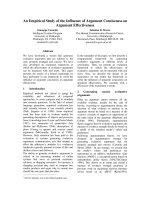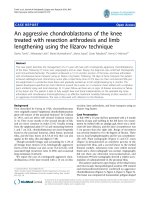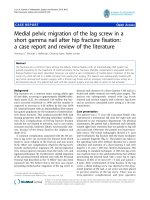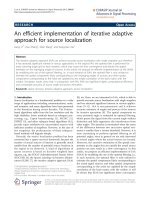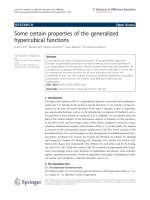Báo cáo toán học: "An entropy proof of the Kahn-Lov´sz theorem a" ppsx
Bạn đang xem bản rút gọn của tài liệu. Xem và tải ngay bản đầy đủ của tài liệu tại đây (114.79 KB, 9 trang )
An entropy proof of the Kahn-Lov´asz theorem
Jonathan Cutler
Montclair State University
A.J. Radcliffe
University of Nebraska-Lincoln
Submitted: Jun 9, 2010; Accepted: Dec 16, 2010; Published: Jan 5, 2011
Mathematics Subject Classification: 05C35
Abstract
Br`egman [2], gave a best possible upper bound for the number of perfect m atch-
ings in a balanced bipartite graph in terms of its degree sequence. Recently Kahn
and Lov´asz [8] exten ded Br`egman’s theorem to general graphs. In this paper, we
use entropy m ethods to give a new proof of the Kahn-Lov´asz theorem. Our methods
build on Rad hakrishnan’s [9] use of entropy to prove Br`egman’s theorem.
1 Introduction
Entropy has recently emerged as a powerful tool in combinatorics (see for instance [3, 6,
7]). Radhakrishnan [9] used entropy to give a new proof of Br`egman’s theorem. While
Br`egman’s theorem is usually stated in terms of the permanent of a square (0, 1)-matrix,
the equivalent version we state uses graph theoretic nota t ion. If G is a g r aph, we let Φ(G)
be the set of perfect matchings of G and φ(G) = |Φ(G)|. Also, if v ∈ V (G), we denote
the degree o f v by d(v).
Theorem 1 (Br`egman [2]). If G = G(L, R) is a bipartite graph such that |L| = |R|, then
φ(G) ≤
v∈L
(d(v) !)
1/d(v)
.
The extension of Br`egman’s theorem to general graphs was achieved by Kahn and
Lov´asz [8], and independently proved by Friedland [4].
Theorem 2 (Kahn-Lov´asz [8]). For G an arbitrary graph,
φ(G) ≤
v∈V
(d(v) !)
1/(2d(v))
.
the electronic journal of combinatorics 18 (2011), #P10 1
The original proof of Kahn and Lov´asz was never published, see [3]. Friedland’s proof
is based on an extension of Schrijver’s [10] proof of the Br`egman inequality. A short proof,
deducing the result for general graphs from Br`egman’s theorem, was given by Alon and
Friedland [1]. This paper presents a new proof of Theorem 2 using entropy methods.
We introduce the basics of entro py that will be used in this paper. For a more compre-
hensive introduction, see, e.g., [5]. In the following definition, and throughout this paper,
all logarithms are base two, and all random variables have finite range.
Definition 1. The entropy o f a random variable X is given by
H(X) =
x
P(X = x) log
1
P(X = x)
.
For random variables X and Y , the conditional en tropy of X given Y is
H(X
Y ) = E(H(X
Y = y)) =
y
P(Y = y)H(X
Y = y).
Both entropy and conditional entropy are a lways non-negative.
One can think of the term log(1/P(X = x)) appearing in the definition of the entropy
as measuring the surprise involved in discovering that the value of X turned out to be
x (measured on a logarithmic scale). In these terms H(X) is the expected surprise in
learning the value of X. The conditional entropy H(X
Y ) is the expected surprise in
learning the value o f X given that the value of Y is known. The chain rule (part b) below)
shows that also H(X
Y ) = H((X, Y )) −H(Y ). The following theorem collects the basic
facts about entropy that we will need.
Theorem 3.
a) If X is a rando m varia ble then
H(X) ≤ log |range(X)| ,
with equality if and only if X is unifo rm on its range.
b) If X = (X
1
, X
2
, . . . , X
n
) is a random sequence then
H(X) = H(X
1
) + H(X
2
X
1
) + · · · + H(X
n
X
1
, X
2
, . . . , X
n−1
).
c) If X, Y, Z are random variables then
H(X
Y, Z) ≤ H(X
Y ).
d) If X, Y, Z are random variables and Z is Y -measurable then
H(Y, Z) = H(Y ) and H(X
Y, Z) = H(X
Y ).
the electronic journal of combinatorics 18 (2011), #P10 2
Part c) above is the natural fact that knowing more information does not increase your
expected surprise—part d) says that if you could have worked out the extra information
for yourself then there is no change in your expected surprise.
In Section 2, we present Radhakrishnan’s entropy proof of Br`egman’s theorem as a
consequence of his randomized version of the chain rule. Although the argument is exactly
that of Radhakrishnan, we believe that its presentation herein presents the ideas clearly
and succinctly. In addition it provides a framework for understanding our proof of the
Kahn-Lov´asz, which we present in Section 3.
2 Radhakrishnan’s proof
This section presents the entropy proof of Radhakrishnan of Br`egman’s theorem, which
is as follows.
Theorem 1. If G = G(L, R) is a bipartite g raph such that |L| = |R|, then
φ(G) ≤
v∈L
(d(v) !)
1/d(v)
.
The key idea of Radhakrishnan’s proof was to introduce a randomized version of the
chain rule. This idea has been used in other entropy proofs and seems to be a powerful
tool when applying entropy methods to combinatorial problems.
Theorem 4 (Radhakrishnan). Suppose X = (X
i
)
i∈I
is a random vector and A is an
arbitrary covering of I. Let be an ordering on A chosen randomly (not necessarily
uniformly). Then
H(X) =
A∈A
H(X
A
, X
B
, B ≺ A).
Proof. We prove it for a fixed ordering , and the general result follows by averaging.
First note that H(X) = H ((X
A
)
A∈A
) by repeated application of Theorem 3, part d).
Thus, by the chain rule,
H(X) = H ((X
A
)
A∈A
) =
A
H(X
A
|X
B
, B ≺ A).
We are now ready to present the entropy proof of Theorem 1 due to R adhakrishnan.
The proof proceeds by applying the randomized chain rule above with respect to orderings
of the vertices in L. For a fixed matching, then, if we proceed thro ugh a particular
ordering, each vertex of L has a certain subset of its neighbors as potential partners in
the matching. The number of such potential partners turns out to be uniform on the
possibilities, and the result follows.
the electronic journal of combinatorics 18 (2011), #P10 3
Proof of Theorem 1. Let M be a perfect matching of G chosen uniformly at random
from Φ(G), and let X = (X
e
)
e∈E(G)
be the indicator vector of M. We define a covering
A = {A
v
: v ∈ L} by A
v
= {vw : w a neighbor of v}. For v ∈ L we define X
v
to
be the unique M-neighbor of v, and note that X
v
and X
A
v
contain precisely the same
information. Given chosen uniformly at ra ndom from the set of all total orderings of
L (and independently of M), we define N
v
= |A
v
\ {vX
w
: w v}|. Later, in Lemma 6,
we give the easy proof that for any fixed perfect matching m we have
P(N
v
= k
M = m) =
1
d(v)
, for all k = 1, 2, . . . , d(v).
As P(N
v
= k
M = m) = 1/d(v) for any fixed m we see that N
v
is uniformly distributed
on {1, 2, . . . , d(v)}. Now, by Theorem 4 followed by standard uses of the properties of
entropy from Theorem 3,
H(X) =
v
H(X
v
| , X
w
, x v)
≤
v
H(X
v
| , N
v
)
≤
v
H(X
v
|N
v
)
=
v
d(v)
k=1
P(N
v
= k)H(X
v
|N
v
= k)
≤
v
d(v)
k=1
1
d(v)
log(k)
=
v
log(d(v)!)
1/d(v)
.
3 A proof of the Kahn-Lov´asz theorem
The entropy proof of the Kahn-Lov´asz theorem is complicated by the fact that there can
be edges of the graph (and a fixed matching) amongst the neighbors of a pa rt icular vertex.
Thus the analogue of the statement that N
v
is uniformly distributed is no longer true.
However, we still are a ble to give a n entropy bound that proves the theorem.
We discuss a slight generalization of the problem that we face. We discuss the process
of picking a random element from a family of sets, where some have already been ruled out.
These are the ones appearing before some distinguished element in a random ordering. In
the graph context we will have a random ordering on edges of a fixed matching incident
to neighbo r s of a vertex v—the distinguished element will be t he matching edge incident
with v.
the electronic journal of combinatorics 18 (2011), #P10 4
Definition 2. Suppose that A = (A
x
)
x∈I
is a family of non-empty disjoint finite sets and
let ⋆ be a distinguished element of I. We require |A
⋆
| = 1. Suppose that is a uniformly
random (total) ordering of I. We define a random variable X
A
that we call a uniform
random l ate choice from A by picking an element of
x⋆
A
x
uniformly at random. For
notational convenience we define
U(A, ) =
x⋆
A
x
.
In the next lemma we prove that a certain conditional entropy a ssociated with a
random late choice is greatest when all the A
x
are singletons. In our graph context this
corresponds to the situation when there are no matching edges between neighbors of v.
Lemma 5. Let A = (A
x
)
x∈I
be a family of non-empty disjoint finite sets and be a
uniform random ordering on I. Let B be the family ({a})
a∈U
, where U =
x∈I
A
x
, and
let
B
be a uniformly random ordering on U. We wri te n for |U|. Then
H(X
A
) ≤ H(X
B
B
) =
log(n!)
n
,
with equality if and only if |A
x
| = 1 for all x ∈ I.
Proof. Set k = |I|. For each value of n, we prove the result by downwards induction on
k. The case k = n is precisely the equality in the statement of the lemma. In this case
we have
H(X
A
) =
1
n!
log |U(A, )|
=
1
n!
log |{x ∈ I : x ⋆}|
=
n
i=1
1
n!
{ : |{x ∈ I : x ⋆}| = i}
log(i)
=
n
i=1
1
n
log(i)
=
log(n!)
n
.
Suppose then that k < n. There exists some A
x
with |A
x
| ≥ 2. Note that x = ⋆, since by
definition |A
⋆
| = 1. We will build a family A
′
that is identical with A except that A
x
is
split into two nonempty parts, A
x
′
and A
x
′′
. ( Here we have introduced two new elements
into the index set and deleted x, so I
′
= I \ {x} ∪ {x
′
, x
′′
}.) We introduce a new uniform
random ordering
′
on I
′
. We will show
H(X
A
) < H(X
A
′
′
) ≤
log(n!)
n
.
the electronic journal of combinatorics 18 (2011), #P10 5
To be precise, we show that for a fixed ordering
0
on I
0
= I \{x}, the total contribution
to H(X
A
) coming from orderings on I which restrict to
0
on I
0
is no bigger than
the total for H(X
A
′
′
) where again
′
restricts to
0
. I.e., we show
1
k!
|
I
0
=
0
log (|U(A, )|) <
1
(k + 1)!
′
′
|
I
0
=
0
log (|U(A
′
,
′
)|) . (†)
We let
S = |U(A \ {A
x
} ,
0
)| , d
′
= |A
x
′
| , d
′′
= |A
x
′′
| , and d = |A
x
| = d
′
+ d
′′
.
Since the position of ⋆ in
0
is fixed, the only relevant issues are the positions of x in
and x
′
, x
′′
in
′
. Suppose that ⋆ is the j
th
smallest element in
0
. The possible values
for |U(A, )| are S and S + d. There are j orderings (exactly those in which x appears
before ⋆) for which the value is S, and k − j for which the value is S + d. (Note that since
there are k − 1 elements of I
0
, there are k positions in which x can be inserted.) Similarly,
the four possible values for |U(A
′
,
′
)| are S, S + d
′
, S + d
′′
, and S + d, with respective
frequencies j(j + 1) , j(k − j), j(k − j), and (k − j)(k − j + 1). Therefore, proving (†) is
equivalent to proving (after multiplying by (k + 1)! and exponentiating)
S
j
(S + d)
k−j
k+1
< S
j(j+1)
(S + d
′
)
j(k−j)
(S + d
′′
)
j(k−j)
(S + d)
(k−j)(k−j+1)
.
Canceling common factors, this is equivalent to
S
j(k−j)
(S + d)
j(k−j)
< (S + d
′
)
j(k−j)
(S + d
′′
)
j(k−j)
.
Taking the j(k − j)
th
root, this is S(S + d) = S
2
+ dS < S
2
+ dS + d
′
d
′′
.
The other ingredient o f our proof is the idea, due to Cuckler and Kahn [3], of exploiting
the fact that a uniformly random ordering on the vertices of G induces a uniformly random
ordering o n the edges of any fixed perfect matching. If the vertices of a gra ph G are
ordered by labeling them 1, 2, . . . , n, then, for any subset of edges F ⊆ E(G), we define
the induced le x i cographic ordering on F to be the lexicographic or dering on F , where
edges are thought of as elements of
[n]
2
.
Lemma 6. Let G be a graph and m a perf ect matching in G. If
V
is a random ordering
of V (G), we define
E
to be the induced lexicographic ordering on m. Then
E
is uniform
on the set of all orders of m. Moreover, f or a particular edge xy ∈ m, the ordering
E
is
independent of the event {x
V
y}.
Proof. For any permutation of the edges of m, there is a permutation of V (G) inducing
it. Therefore, the uniformity of
V
implies that of
E
. Similarly, the transposition (x y)
maps the event {
E
=
0
, x
V
y} to the event {
E
=
0
, y
V
x} and hence, by the
uniformity of
V
,
P(
E
=
0
, x
V
y) = P(
E
=
0
, y
V
x),
i.e.,
E
is independent of the event {x
V
y}.
the electronic journal of combinatorics 18 (2011), #P10 6
We now describe the setup that allows us to connect uniform random late choices and
the Kahn-Lov´asz theorem.
Definition 3. Given a graph G, a vertex v ∈ V (G), and a perfect matching m ∈ Φ(G),
we define
I
v
= {e ∈ m : e is incident with a neighbor of v} .
If e ∈ I
v
, we set
A
e
= e ∩ N(v),
so that if w is a neighb or of v whose m-neighbor u is also adjacent to v, then A
wu
= {w, u},
whereas if u is not adjacent to v (in particular if u = v), then A
wu
= {w}. We let
A
v
= {A
e
: e ∈ I
v
}, from which we distinguish the element {v
′
} = A
{v,v
′
}
, where v
′
is the
m-neighbor of v. Also, given a uniform random ordering
V
on V , we define N
v
to be
the random variable
N
v
=
|{w ∼ v : w
V
v and u
V
v where u is the m-neighbor of w}| if v ≺
V
v
′
,
0 otherwise.
Our final lemma relates the entropy of a random late choice from A
v
to the distribution
of N
v
.
Lemma 7. With the setup of the previous definition, if X
A
v
is a unif orm random late
choice from A
v
then
H(X
A
v
I
v
) =
d
v
i=1
P(N
v
= i
v ≺
V
v
′
) log(i). (‡)
Proof. Let k = |A
v
| and n = | V (G)|. We have
H(X
A
v
I
v
) =
1
k!
I
v
log (|U(A
v
,
I
v
)|) =
1
n!
V
log (|U(A
v
,
I
v
)|) .
We note that if v ≺
V
v
′
, then |U(A
v
,
I
v
)| = N
v
, where the right-hand side, being a
random va r ia ble, is a function of
V
. Otherwise, of course, N
v
= 0. By Lemma 6, the
event {v ≺
V
v
′
} is independent of the induced ordering
I
v
so
1
n!
V
log (|U(A
v
,
I
v
)|) =
2
n!
V
v≺
V
v
′
log (|U(A
v
,
I
v
)|) .
Therefore
H(X
A
v
I
v
) =
2
n!
V
v≺
V
v
′
log (|U(A
v
,
I
v
)|) =
d
v
i=1
P(N
v
= i
v ≺
V
v
′
) log(i).
the electronic journal of combinatorics 18 (2011), #P10 7
We are now ready to prove the Kahn-Lov´asz theorem.
Proof of Theorem 2. Let M be a perfect matching of G chosen uniformly at random from
Φ(G), and let X = (X
e
)
e∈E
be the indicator vector of M. Fo r v ∈ V (G), we also set X
v
=
w where vw ∈ M. We pick a uniformly random total ordering
V
on V (G). We let Q
v
be the indicator r andom variable for the event {X
v
≺
V
v} = {v = X
w
for some w ≺
V
v}.
We have
log(φ(G)) = H(X)
=
v∈V
H
X
v
(X
w
, w ≺
V
v),
V
=
v∈V
H
X
v
N
v
, Q
v
, (X
w
, w ≺
V
v),
V
(1)
≤
v∈V
H
X
v
N
v
, Q
v
=
v∈V
P(Q
v
= 1) H
X
v
N
v
, Q
v
= 1
+
v∈V
P(Q
v
= 0) H
X
v
N
v
, Q
v
= 0
=
1
2
v∈V
H
X
v
N
v
, Q
v
= 0
=
1
2
v∈V
d
v
k=1
P(N
v
= k, Q
v
= 0)H
X
v
N
v
= k, Q
v
= 0
≤
1
2
v∈V
d
v
k=1
P(N
v
= k, Q
v
= 0) log(k)
=
1
2
v∈V
d
v
k=1
m∈Φ(G)
P(N
v
= k, Q
v
= 0
M = m) log(k)P(M = m)
=
1
2
v∈V
m∈Φ(G)
H(X
A
v
I
v
)P(M = m) (2)
≤
1
2
v∈V
m∈Φ(G)
P(M = m)
log(d
v
!)
d
v
(3)
=
1
2
v∈V
1
d
v
log(d
v
!).
Here (1) is a consequence the fact that Q
v
and N
v
are ((X
w
, w ≺
V
v),
V
)-measurable,
(2) is an application of Lemma 7, and (3) follows from Lemma 5.
the electronic journal of combinatorics 18 (2011), #P10 8
References
[1] Noga Alon and Shmuel Friedland, The maximum number of perfect matchings in
graphs with a given degree sequence, Electron. J. Combin. 15 (2008), no. 1, Note 13,
2. MR MR2398830 (2009b:05210)
[2] L. M. Br`egman, Certain properties of nonnegative matrices and their permanents,
Dokl. Akad. Nauk SSSR 211 (1973), 27–30. MR MR0327788 (48 #6130)
[3] Bill Cuckler and Jeff Kahn, Entropy bounds for perfect matchings and Hamiltonian
cycles, Combinatorica 29 (2009), no. 3, 327–335. MR MR2520275
[4] Shmuel Fr iedland, An upper bound for the number of perfect matchings in graphs,
arXiv (2008), 0 803.0864v1.
[5] Charles M. Goldie and Richar d G. E. Pinch, Com munication theory, London Math-
ematical Society Student Texts, vol. 20, Cambridge University Press, Cambridge,
1991. MR MR1143777 (93a:94001)
[6] Jeff Kahn, An entropy app roach to the hard-core model on bi partite graphs, Combin.
Probab. Comput. 10 (2001), no. 3, 219–237. MR MR18 41642 (2003a:05111)
[7] , Entropy, independent sets and antichains: a new approach to Dedekind’s
problem, Proc. Amer. Math. Soc. 130 (2002), no. 2, 371–378 (electronic). MR
MR1862115 (2002j:05011)
[8] Jeff Kahn and L´aszl´o Lov´asz, unpublished.
[9] Jaikumar Radhakrishnan, An entropy proof of Bregman’s theorem, J. Combin. Theory
Ser. A 77 (1997), no. 1, 161–164. MR MR1426744 (97m:15006)
[10] A. Schrijver, A short proof of Minc’s conjecture, J. Combinatorial Theory Ser. A 25
(1978), no. 1, 80–83. MR MR0491216 (58 #10481)
the electronic journal of combinatorics 18 (2011), #P10 9


